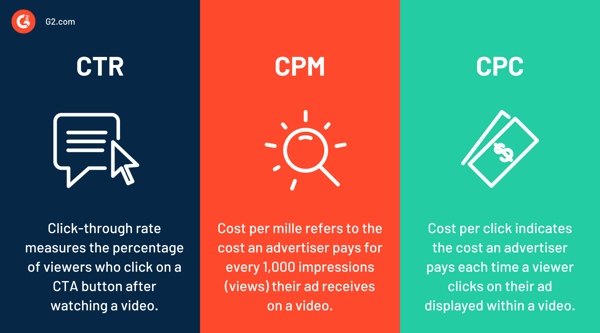March 5, 2024
 by Divyesh Patel / March 5, 2024
by Divyesh Patel / March 5, 2024

Do you know if your videos are resonating with viewers and driving action?
Determining the right video metrics to track is the first step towards learning to measure the success of your video marketing strategy.
Video creators use various metrics to assess the performance of their content. Metrics like views, watch time, shares, and comments are useful engagement metrics that show how users interact with their content.
However, audience insights are critical for refining content strategy. Understanding data such as the demographic and geographic location of the viewers helps creators create videos that appeal to specific groups.
For creators considering making an impact in video content marketing, a planned mix of engagement, demographic, and monetization analytics is required to optimize their content and prosper in the competitive arena.
Let’s dive deep into video metrics and examine the top KPIs marketers should follow to optimize video performance.
With over 98% of marketers viewing video marketing as an integral part of marketing strategies, understanding key video metrics separates creators who thrive from those left in the dark.
This includes understanding and tracking data on how your audience interacts with your videos, whether they reach the right audiences, engage them, etc. You may then use these data to improve the effect of your videos and increase organic growth.
Here are the top reasons why video metrics are critical to any marketing campaign.
Video metrics help you understand what makes your audience tick. They show how viewers interact with your content and provide invaluable insights into their preferences and sentiments.
For instance, if you notice a surge in likes, comments, and shares on a particular video, it shows your content resonates with a large audience. Based on these insights, you can strategically fine-tune your future content to align with the preferences and emotions of your viewers.
Timing is everything, especially in video content.
As marketers, you need to pay attention to metrics like real-time viewers and maximum concurrent users to pinpoint peak traffic hours, which tells you when your audience is most engaged. Knowing these optimal times can significantly impact your video's reach.
For instance, if you're a fitness influencer and notice a surge in viewers during your morning workout videos, it's a cue to focus on that time slot.
Tracking video metrics lets you tweak content delivery for different devices and platforms. It ensures your content hits the right audience at the right time.
Making your content more effective isn't just about changing keywords. It's a more detailed process based on data.
Low video completion rates signal potential content issues. Or, say your video play rate is falling behind — it could likely mean your video placement is not optimal.
With access to key metrics like view count, completion rates, play rates, and click-through rates, you have actionable insights for optimizing your content. You can perhaps adjust your video duration or alter your call-to-action placement to improve performance and reap maximum ROI across various channels.
Tying video engagement to tangible business outcomes is the ultimate goal of a marketer. You can leverage engagement metrics (conversion rates and follower or subscriber growth) to align with your broader business objectives and achieve positive ROI.
For instance, if your subscriber count goes up after a video campaign, it's an obvious win, right?
With metrics, you justify your investment and refine your strategies for more impactful results. They prove that your videos aren't just entertaining; they're driving actual actions, aligning with your business goal of growing a dedicated audience.
Let’s look at the top video metrics every video creator and publisher should track.
Engagement is likely one of the best cues indicating the level of your video's organic reach. It provides valuable qualitative insights like:
One of the key metrics for video creators to keep an eye on is views and watch time. Views indicate the total number of people who have watched your video, while watch time tells you how long they stuck around. These metrics give a clear picture of your video's initial appeal and how engaging your audience finds your content.
For instance, if your DIY tutorial video is getting a lot of views but a short watch time, it might be worth tweaking the video — perhaps add a catchy hook and engaging elements throughout the video to keep viewers interested till the end.
Digging deeper, the completion rate and average watch time offer insights into viewer engagement.
The completion rate indicates the percentage of viewers who watched your video till the end, indicating whether or not your content is holding their interest. On the other hand, average watch time provides insight into how long, on average, people spend on your video. Together, they help creators understand the level of engagement their videos are providing throughout the video.
Simply put, a longer watch time signifies a highly captivated audience, while a shorter one indicates room for improvement at your end.
Likes, shares, and comments are social indicators of a video's impact. People share content that aligns with their ideal self, which goes to say they trust and support your brand. Comments, on the other hand, indicate the emotional impact your video has had on watchers.
If an inspirational video appears to motivate them or a controversial video seems to rile them up, you can accordingly decide what to focus on in the future. Evidently, if more viewers like your video, share it with others, or leave comments, it signifies a higher level of engagement.
As you can understand, such engagement metrics go beyond passive watching; they incite an active response from your audience — and monitoring such social interactions can help you gauge the emotional connection and relatability your content is building with your viewers.
In-depth audience insights form the bedrock for creating compelling and relevant videos that captivate diverse audiences across various demographics and geographic locations.
Understanding your audience's demographics means tracking their age, gender, and specific interests to get a clear picture of the persona behind this data. This can help you craft content that speaks directly to them based on their preferences and inclinations.
Beyond that, geographic data adds a layer to making your content foolproof since you can tailor your videos to incorporate an understanding of cultural preferences in different regions.
From language nuances to region-specific references, you can ensure your video resonates on a deeper level with diverse viewers.
Analyzing video metrics also gives insight into where most of your traffic comes from—whether through social media, search engines, or direct visits.
This guides you in promoting and sharing your videos on channels that attract the most action. Similarly, you can also track the devices your audience prefers to watch your videos.
For instance, if your audience typically uses mobile or smart TVs to consume your content, you can optimize your videos for a better viewing experience on those devices.
Understanding where your viewers find your content and what channels, platforms, or devices they use is crucial for tailoring it to exactly how they like.
Video creators and publishers must closely monitor monetization metrics to track the financial success of their content.
These include crucial video metric analytics like click-through rate (CTR), cost per mille (CPM), and cost per click (CPC).

Source: Gumlet
CTR is a crucial metric, particularly for video ad campaigns, since it indicates the percentage of viewers who followed up on the action you intended them to take, i.e., clicked on the call-to-action (CTA) button.
This metric is pivotal for understanding how well your video content can persuade viewers to move from the video to a landing page or take a desired action. A low CTR may indicate that you need to optimize CTA placement or make the video more engaging to prompt more clicks.
CPM is a key monetization metric representing the cost of 1,000 impressions or views of an advertisement. Simply put, it helps video creators understand how much they spend to reach 1000 viewers.
CPM is particularly relevant in ad-based monetization models, where creators can assess the cost-effectiveness of their campaigns by measuring the CPM and optimizing their ad revenue strategies based on that.
CPC is another vital monetization metric, especially in video advertising. It signifies the cost incurred by the advertiser each time a viewer clicks on the ad. Publishers and creators should closely monitor CPC to evaluate whether their video content effectively drives user engagement.
A lower CPC indicates that you have a more cost-effective strategy — which allows creators to drive maximum revenue while optimizing content for audience interaction.
Creating captivating video content is just the first step.
To ensure your videos resonate with viewers and achieve wider reach, understanding how to optimize them for different platforms best is essential.
Social media platforms contain a massive potential audience. You can ensure your content stands out by understanding the specific requirements and audience preferences across platforms.
To maximize video performance, you need to tailor your content and promotional strategies to each social media platform's different formats and audiences.
For example, TikTok, a platform dominated by a younger demographic with a demand for rapid, engaging content, concentrates on short-form vertical videos. So, you might look to include trendy challenges or music in your videos to connect with TikTok's creative culture.
You can provide elaborate explanations or comprehensive guides on YouTube, where audiences frequently seek in-depth tutorials or longer-form content. Consider the platform's algorithms and audience behavior to guarantee your content aligns with the platform's expectations.
Also, when creating content for YouTube, it's important to note that the platform primarily uses a 16:9 aspect ratio, which is ideal for both desktop and mobile viewing, ensuring your videos look professional and fit well on various screens.
Ask yourself what elements of your content strategy need adjustment to resonate effectively with each platform's specific audience and format.
Only by understanding the specific nuances of each platform can you craft content that resonates effectively and engages the right audience.
Effective video optimization refers to consistently tracking and analyzing key performance indicators (KPIs). This means metrics such as view count, watch time, and engagement provide valuable insights into your audience and video performance.
Dive into the specifics.
Understand which videos are gaining traction, analyze patterns in watch time, and evaluate audience interactions through comments and likes. What this does is help you identify trends, dive deeper into audience preferences, and make informed, data-driven decisions.
New content creators often overlook the significance of analyzing video drop-off points — a powerful tool for refining content for sustained audience engagement. This involves identifying specific moments in a video where viewers disengage or exit.
Ask yourself — are there recurring patterns in drop-off points across your videos? Dig deeper and determine why viewers may be losing interest at these points and how you can adjust content elements at these critical junctures to positively impact completion rate and watch time.
Such a proactive approach will minimize drop-offs and enhance viewer retention and engagement.
A/B testing involves creating two or more versions of a video, wherein you tweak specific elements, publish both versions, and compare their performance to figure out which resonates better with your audience.
It lets you experiment with different thumbnails, video titles, and narrative structures. You can try multiple video CTAs to see which ones attract more clicks. And so on.
With A/B testing in your video content strategy, you can move beyond assumptions and guesswork and adapt your content based on changing audience preferences and platform dynamics for better engagement and reach.
Let's look at the top challenges video creators and publishers typically face in video marketing.
Problem: Creators often grapple with retaining viewer engagement, leading to significant drop-off rates in their videos.
This can result in missed opportunities for conveying key messages or calls to action, impacting overall video effectiveness and audience retention.
Solution: Addressing high drop-off rates requires a strategic approach. You must dive deep into audience retention metrics to identify drop-off points. Once you determine where viewers lose interest, make adjustments as needed.
Experiment with video length and content structure, and tailor content to align with your audience's preferences. Ensure you have compelling intros and visuals, and your videos follow a cohesive narrative to sustain viewer interest.
Remember, each video should offer a captivating and valuable experience.
Problem: Video creators may encounter challenges in effectively monetizing content and maximizing revenue potential. This can hinder the sustainability of your content creation efforts and limit your financial returns.
Solution: To optimize monetization strategies, it is essential to have a comprehensive understanding of key metrics such as revenue per mille (RPM) and ad CTR to gain insights into the effectiveness of your advertising and revenue generation strategies.
Another great strategy is to explore alternative revenue streams beyond traditional ads, like sponsorships, affiliate marketing, and selling merchandise.
You should also collaborate with brands that resonate with your audience and focus on building strategic partnerships that enhance monetization opportunities and bring about content authenticity.
Problem: Not all videos are likely to resonate equally with the audience; some may perform exceptionally well, while others may register a lukewarm response. Inconsistent visibility poses challenges in maintaining a stable audience base.
Solution: To tackle this, it is best to conduct A/B testing. Experiment with different subjects, video formats, thumbnails, titles, etc. This will allow you to compare and identify what elements resonate best with your audience.
As you regularly indulge in A/B testing and gain real-time audience feedback, you can extract trends and patterns in successful content and replicate those in future videos.
Problem: Creators may struggle to reach and engage their target audience effectively. This can result in a disconnect between content and audience, affecting your overarching marketing goals.
Solution: Leverage the power of demographic and geographic data available in analytics tools. Find out more about your audience — their age, gender, and location — and tailor your content accordingly.
Look for specific interests and preferences of your target demographic, such as what devices they use, which channels they frequent, how they prefer to consume content, etc.
This personalized approach can help establish a strong connection with your intended audience.
Successful video marketing requires a strategic blend of creativity, analytics, and audience understanding. Now you have the metrics, and it’s just a matter of tracking them regularly.
At every stage of your video marketing strategy, you need to consider what audience engagement metrics are most relevant to your content and how you can leverage them for improvement.
Embracing a data-driven approach, continually refining your content based on insights, and regularly adapting to evolving audience preferences will optimize your content performance and position you for sustained success in the competitive landscape of video marketing.
Elevate your video marketing game! Discover the essential role of video hosting and why marketers need it for insights that will transform your approach to video content.
Edited by Shanti S Nair
Divyesh Patel is the co-founder and CMO of Gumlet. He is a passionate entrepreneur with a background in engineering and marketing. He is a thought leader in the video and image optimization space and is passionate about helping businesses leverage media to achieve their goals.
Video is one of the best tools marketers and business owners can use to build brand awareness,...
 by Katie Duncan
by Katie Duncan
Online videos are so ubiquitous today that customers are only shocked when they don’t use...
 by Tyler Lessard
by Tyler Lessard
Ever hit “record” only to find yourself stumbling through your words, unsure of what to say...
 by George Rowlands
by George Rowlands
Video is one of the best tools marketers and business owners can use to build brand awareness,...
 by Katie Duncan
by Katie Duncan
Online videos are so ubiquitous today that customers are only shocked when they don’t use...
 by Tyler Lessard
by Tyler Lessard


